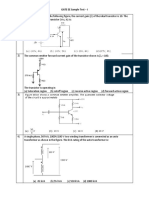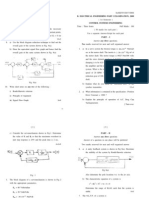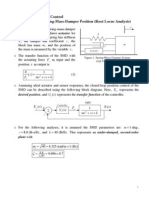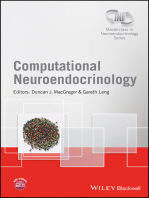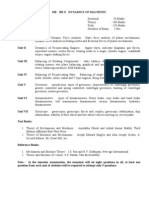Homework 6 (Chapter 7) : S S S S S S S S G
Homework 6 (Chapter 7) : S S S S S S S S G
Uploaded by
Eugine BalomagaCopyright:
Available Formats
Homework 6 (Chapter 7) : S S S S S S S S G
Homework 6 (Chapter 7) : S S S S S S S S G
Uploaded by
Eugine BalomagaOriginal Description:
Original Title
Copyright
Available Formats
Share this document
Did you find this document useful?
Is this content inappropriate?
Copyright:
Available Formats
Homework 6 (Chapter 7) : S S S S S S S S G
Homework 6 (Chapter 7) : S S S S S S S S G
Uploaded by
Eugine BalomagaCopyright:
Available Formats
Homework 6 (Chapter 7)
1. For the unity feedback system shown in Figure P7.1, where
450( s 8)( s 12)( s 15)
G(s)
s ( s 38)( s 2 2 s 28)
find the steady-state errors for the following test inputs: 25 u (t ) , 37
tu (t ) , 47 t 2 u (t ) .
2. For the unity feedback system shown in Figure P7.1, where
5000
G ( s)
s ( s 75)
a. What is the expected percent overshoot for a unit step input?
b. What is the settling time for a unit step input?
c. What is the steady-state error for an input of 5 u (t ) ?
d. What is the steady-state error for an input of 5 tu (t ) ?
e. What is the steady-state error for an input of 5 t 2 u (t ) ?
3. Given the unity feedback system shown in Figure P7.1, where
100( s 2)( s 9)
G( s)
s ( s 18)( s )( s 10)
find the value of to yield a K v 1000 .
4. For the system shown in Figure P7.5:
a. What value of K will yield a steady-state error in position of
0.1 for an input of (1/10)t?
b. What is K v for the value of K found in (a)?
c. What is the minimum possible steady-state position error for the
input given in (a)?
5. The unity feedback system of Figure P7.1, where
K ( s 2 3s 30)
G ( s)
s n ( s 5)
is to have 1/6000 error between an input of 10 tu (t ) and the output
in the steady-state.
a. Find K and n to meet the specification.
b. What are K p , K v , and K a ?
6. Given the unity feedback control system of Figure P7.1, where
K
G (s)
s( s a)
find the following:
a. K and a to yield K v 1000 and a 20% overshoot
b. K and a to yield a 1% error in the steady state and a 10%
overshoot
7. Find the total steady-state error due to a unit step input and a unit
step disturbance in the following system.
8. The following specification applies to a position control: K v = 10.
On hand is an amplifier with a variable gain, K 2 , with which to
drive a motor. Two one-turn pots (potentiometers) to convert shaft
position into voltage are also available, where 3 volts are placed
across the pots. A motor is available whose transfer function is
m ( s) K
Ea (s) s(s )
where m (s ) is the motor armature position and E a (s ) is the
armature voltage. The components are interconnected as shown in
the following figure.
The transfer function of the motor is found experimentally as
follows. The motor and load are driven separately by applying a
large, short square wave (a unit impulse) to the armature. An
oscillograph of the response shows that the motor reached 63﹪of its
final output value 0.5 second after application of the impulse.
Furthermore, with 10 volts dc applied to the armature, the constant
output speed was 100 rad/s. Draw the completed block diagram of
the system, specifying the transfer function of each component of the
block diagram.
You might also like
- Unilag Engineering BrocchureDocument21 pagesUnilag Engineering Brocchurejimiolan58% (12)
- Problema B.5.1 OgataDocument2 pagesProblema B.5.1 OgataOscar Mtz Fts50% (2)
- Problem 2Document4 pagesProblem 2Jade Do0% (1)
- Solution Skill Assessment Nise 6thDocument54 pagesSolution Skill Assessment Nise 6thNur Farah Diyana Sabarudin100% (9)
- EE206 Control Systems Tutorial - 18Document5 pagesEE206 Control Systems Tutorial - 18Haelu KuNo ratings yet
- TUTORIAL 7 - Steady-State ErrorDocument4 pagesTUTORIAL 7 - Steady-State ErrortiraNo ratings yet
- Control System Tutorial KGPDocument2 pagesControl System Tutorial KGPOjaswa AnandNo ratings yet
- Boun Ee 450 Homework 3Document2 pagesBoun Ee 450 Homework 3Ogulcan BaycanNo ratings yet
- Chap5&6. HWDocument11 pagesChap5&6. HWJesse Isaac McCallNo ratings yet
- AE61Document4 pagesAE61Anima SenNo ratings yet
- CS ASS2 (13-17batch)Document3 pagesCS ASS2 (13-17batch)Anonymous yO7rcec6vuNo ratings yet
- EC6405-Control Systems EngineeringDocument12 pagesEC6405-Control Systems EngineeringAnonymous XhmybK0% (1)
- SriDocument123 pagesSriUgochukwu FidelisNo ratings yet
- Acs 2018s2 Assn1Document4 pagesAcs 2018s2 Assn1MiraelNo ratings yet
- Electrical Machines Controls. Ree409Document4 pagesElectrical Machines Controls. Ree409Arshad SaifiNo ratings yet
- QUESTION BANK of Control Systems Engineering PDFDocument12 pagesQUESTION BANK of Control Systems Engineering PDFMouhanit LimbachiyaNo ratings yet
- Control SystemsDocument3 pagesControl SystemsselvajothiNo ratings yet
- TUTORIAL 6 - System ResponseDocument15 pagesTUTORIAL 6 - System ResponsetiraNo ratings yet
- EDCDocument28 pagesEDCzuberbashaNo ratings yet
- Gujarat Technological University: Subject Code:2141004 Subject Name:Control System Engineering Time:10:30 AM To 01:00 PMDocument3 pagesGujarat Technological University: Subject Code:2141004 Subject Name:Control System Engineering Time:10:30 AM To 01:00 PMvisupinuNo ratings yet
- Antenna Azimuth:An Introduction To Position Control SystemsDocument4 pagesAntenna Azimuth:An Introduction To Position Control SystemsMpho Senior0% (1)
- Compre Paper - SET 1Document2 pagesCompre Paper - SET 1Arkadeep ChowdhuryNo ratings yet
- Control Systems 2004-05 ComprehensiveDocument5 pagesControl Systems 2004-05 ComprehensiveArkadeep ChowdhuryNo ratings yet
- CSDocument24 pagesCSelangocsNo ratings yet
- Gate Ece 1991Document13 pagesGate Ece 1991reddvoidNo ratings yet
- Tutorial SheetsDocument11 pagesTutorial SheetsKAMARAJU SAI VAMSHINo ratings yet
- Civil Services - Electrical Main Paper I & II - 1992-2012 - 7.6MBDocument253 pagesCivil Services - Electrical Main Paper I & II - 1992-2012 - 7.6MBAnika DixitNo ratings yet
- Automatic Control CH7Document48 pagesAutomatic Control CH7廖偉丞No ratings yet
- RT Exercises and Solutions Med TentatalDocument264 pagesRT Exercises and Solutions Med TentatalSANA100% (1)
- Total Pages: Total Pages: 3: Answer Answer Any Two Full Questions, Each Carries 15 Marks MarksDocument3 pagesTotal Pages: Total Pages: 3: Answer Answer Any Two Full Questions, Each Carries 15 Marks MarksanuNo ratings yet
- Gate Solved Paper - In: Q.1 - 30 Carry One Mark EachDocument20 pagesGate Solved Paper - In: Q.1 - 30 Carry One Mark EachyogeshNo ratings yet
- 130403control System - Unit12Document4 pages130403control System - Unit12Nitin GoyalNo ratings yet
- NDocument367 pagesNNani NRajNo ratings yet
- Gujarat Technological UniversityDocument2 pagesGujarat Technological UniversityHerat HirparaNo ratings yet
- EEF467 Tutorial Sheet 2Document4 pagesEEF467 Tutorial Sheet 2NK-NGAMNo ratings yet
- Ee Sample PaperDocument19 pagesEe Sample Paperjayapriyadarshni12No ratings yet
- Control SystemDocument2 pagesControl Systemguru.rjpmNo ratings yet
- Control Theory QuizDocument28 pagesControl Theory Quizpushplatameena1No ratings yet
- GATE EE Sample Test - IDocument12 pagesGATE EE Sample Test - INayan MannaNo ratings yet
- Computer Science Textbook Solutions - 29Document31 pagesComputer Science Textbook Solutions - 29acc-expertNo ratings yet
- PTEE7301 April-2021Document2 pagesPTEE7301 April-2021imman46920No ratings yet
- Gate - in 2003Document24 pagesGate - in 2003prabhjot singh1No ratings yet
- 2008 ControlDocument3 pages2008 ControlPujan NarjinaryNo ratings yet
- Control Systems 2010-11 ComprehensiveDocument2 pagesControl Systems 2010-11 ComprehensiveArkadeep ChowdhuryNo ratings yet
- Sample Questions For Entrance Test: Fig. 1. Magnitude PlotDocument4 pagesSample Questions For Entrance Test: Fig. 1. Magnitude PlotPadmanabhan.89No ratings yet
- Lecture 2: PID Control of A CartDocument8 pagesLecture 2: PID Control of A CartOğuz Can GüdenNo ratings yet
- EEF467 Tutorial Sheet 3Document4 pagesEEF467 Tutorial Sheet 3NK-NGAMNo ratings yet
- HW CH5Document3 pagesHW CH5DODINo ratings yet
- S S S G: Dynamics and Control-Tutorial QuestionsDocument9 pagesS S S G: Dynamics and Control-Tutorial Questionsahmed357No ratings yet
- Ee304 ADocument3 pagesEe304 AAboo FarisNo ratings yet
- Control Systems: 2. Missing Data, Ifany, May Be Suitably AssumedDocument1 pageControl Systems: 2. Missing Data, Ifany, May Be Suitably AssumedrameshsenaNo ratings yet
- Mech3418 Ca 2016Document4 pagesMech3418 Ca 2016Barry PoonNo ratings yet
- Control SystemsDocument10 pagesControl SystemsSagaraptor RexNo ratings yet
- Pid 2Document5 pagesPid 2Sanyaolu AdebodunNo ratings yet
- MDPN372 PS4 Spring 2021Document5 pagesMDPN372 PS4 Spring 2021akhbar elyoum academyNo ratings yet
- Gate 1991 EeDocument15 pagesGate 1991 EeParayatham ManasaNo ratings yet
- Fundamentals of Electronics 2: Continuous-time Signals and SystemsFrom EverandFundamentals of Electronics 2: Continuous-time Signals and SystemsNo ratings yet
- Power System Transient Analysis: Theory and Practice using Simulation Programs (ATP-EMTP)From EverandPower System Transient Analysis: Theory and Practice using Simulation Programs (ATP-EMTP)No ratings yet
- Computational NeuroendocrinologyFrom EverandComputational NeuroendocrinologyDuncan J. MacGregorNo ratings yet
- Analog Dialogue, Volume 48, Number 1: Analog Dialogue, #13From EverandAnalog Dialogue, Volume 48, Number 1: Analog Dialogue, #13Rating: 4 out of 5 stars4/5 (1)
- Student Solutions Manual to Accompany Economic Dynamics in Discrete Time, second editionFrom EverandStudent Solutions Manual to Accompany Economic Dynamics in Discrete Time, second editionRating: 4.5 out of 5 stars4.5/5 (2)
- Handbook of Power Systems Engineering with Power Electronics ApplicationsFrom EverandHandbook of Power Systems Engineering with Power Electronics ApplicationsNo ratings yet
- N3-Soumatome-KanjiDocument109 pagesN3-Soumatome-KanjiEugine BalomagaNo ratings yet
- Summary of Findings, Conclusion and RecommendationDocument21 pagesSummary of Findings, Conclusion and RecommendationEugine BalomagaNo ratings yet
- Chapter 1Document6 pagesChapter 1Eugine BalomagaNo ratings yet
- Methods and MaterialsDocument10 pagesMethods and MaterialsEugine BalomagaNo ratings yet
- OCCUPATION SAFETY HEALTH WPS OfficeDocument4 pagesOCCUPATION SAFETY HEALTH WPS OfficeEugine BalomagaNo ratings yet
- Performance and Evaluation of Air Conditioning Unit in CEA - Faculty RoomDocument8 pagesPerformance and Evaluation of Air Conditioning Unit in CEA - Faculty RoomEugine BalomagaNo ratings yet
- Tensile Strength of Smaw Dissimilar Joints of Corrugated Steel BarDocument11 pagesTensile Strength of Smaw Dissimilar Joints of Corrugated Steel BarEugine BalomagaNo ratings yet
- GENERIC 22BW-5i 00030Document1 pageGENERIC 22BW-5i 00030Eugine BalomagaNo ratings yet
- Research 1Document55 pagesResearch 1Eugine BalomagaNo ratings yet
- Industrial HygieneDocument16 pagesIndustrial HygieneEugine BalomagaNo ratings yet
- Hazard Identification and Prevention: (Ndlon-Osha)Document12 pagesHazard Identification and Prevention: (Ndlon-Osha)Eugine BalomagaNo ratings yet
- Tensile Strength/yield Strength (TS/YS) Ratios of High-Strength Steel (HSS) Reinforcing BarsDocument9 pagesTensile Strength/yield Strength (TS/YS) Ratios of High-Strength Steel (HSS) Reinforcing BarsEugine BalomagaNo ratings yet
- Industrial Refrigeration TrainerDocument6 pagesIndustrial Refrigeration TrainerEugine BalomagaNo ratings yet
- Game Dumping InstructionsDocument1 pageGame Dumping InstructionsEugine BalomagaNo ratings yet
- Ed 251645Document366 pagesEd 251645Eugine BalomagaNo ratings yet
- Env Professional Stats 0505 0Document59 pagesEnv Professional Stats 0505 0Eugine BalomagaNo ratings yet
- Chapter 5 Reduction of Multiple SubsystemsDocument37 pagesChapter 5 Reduction of Multiple SubsystemsEugine BalomagaNo ratings yet
- Review Related Literature (RRL)Document1 pageReview Related Literature (RRL)Eugine BalomagaNo ratings yet
- The Design and Performance Analysis of Refrigeration System Using R12 & R134a RefrigerantsDocument6 pagesThe Design and Performance Analysis of Refrigeration System Using R12 & R134a RefrigerantsEugine BalomagaNo ratings yet
- B.Sc. (Hons.) Biotechnology Core Course 13: Basics of Bioinformatics and Biostatistics (BIOT 3013) Biostatistics (BIOT 3013)Document29 pagesB.Sc. (Hons.) Biotechnology Core Course 13: Basics of Bioinformatics and Biostatistics (BIOT 3013) Biostatistics (BIOT 3013)Eugine BalomagaNo ratings yet
- T e T As Input. Consider L: Armature Inductance, K Torque Constant, R: Armature Resistance, T: Load TorqueDocument2 pagesT e T As Input. Consider L: Armature Inductance, K Torque Constant, R: Armature Resistance, T: Load TorquePRASANTA ROYNo ratings yet
- Control EngineeringDocument9 pagesControl EngineeringAlexsander JacobNo ratings yet
- Control SystemDocument10 pagesControl SystempriscillaNo ratings yet
- Modeling of Electrodynamic Bearings: Nicola Amati Xavier de Lépine Andrea TonoliDocument9 pagesModeling of Electrodynamic Bearings: Nicola Amati Xavier de Lépine Andrea TonoliDávid RúraNo ratings yet
- WidebandAmplifiers PDFDocument602 pagesWidebandAmplifiers PDFJoseph ReevesNo ratings yet
- Compensator BTechDocument25 pagesCompensator BTechAkash RoyNo ratings yet
- The Dynamics of Aggregate Planning PDFDocument21 pagesThe Dynamics of Aggregate Planning PDFDiego Cortez GranadosNo ratings yet
- Dynamic Response Characteristics of More Complicated ProcessesDocument38 pagesDynamic Response Characteristics of More Complicated Processeshakita86No ratings yet
- Tutorial 1Document12 pagesTutorial 1Beat Boy RkayNo ratings yet
- Analog Comm AssignmentDocument2 pagesAnalog Comm Assignmentksh98No ratings yet
- Linear Fractional Transformation: F: C 7→ C F (s) = a + bs c + ds a, b, c d ∈ C c 6= 0 F (s) = α + βs (1 − γs)Document42 pagesLinear Fractional Transformation: F: C 7→ C F (s) = a + bs c + ds a, b, c d ∈ C c 6= 0 F (s) = α + βs (1 − γs)Thanh VoNo ratings yet
- Control PDFDocument18 pagesControl PDFTaban ShahabNo ratings yet
- Assignment # 01 PDFDocument5 pagesAssignment # 01 PDFRaja Usama RehmanNo ratings yet
- UJ - Control - Semester Test#1 - 13 Sep - 2022Document6 pagesUJ - Control - Semester Test#1 - 13 Sep - 2022Dimakatso NgobeniNo ratings yet
- Control System Unit 1: Ans: ADocument9 pagesControl System Unit 1: Ans: APankaj Kumar MehtaNo ratings yet
- 12 - 1 - 24c - F1B018074 - Baiq Hidayatul ZohriahDocument24 pages12 - 1 - 24c - F1B018074 - Baiq Hidayatul ZohriahRiki SaputraNo ratings yet
- Reformat and Multi ReformatDocument4 pagesReformat and Multi ReformatSreenivas Yadav100% (1)
- Control Systems (CS) : Lecture-6 Steady State ErrorDocument20 pagesControl Systems (CS) : Lecture-6 Steady State ErrorDeepthiNo ratings yet
- Chapter 1Document25 pagesChapter 1Sayed NagyNo ratings yet
- Modeling of Electrical and Mechanical Systems: Lectures 12-15Document87 pagesModeling of Electrical and Mechanical Systems: Lectures 12-15blzz2netNo ratings yet
- Chapter 2 PDFDocument129 pagesChapter 2 PDFMauricio OñoroNo ratings yet
- Control Systems EngineeringDocument119 pagesControl Systems EngineeringksrmuruganNo ratings yet
- Monotonic Behaviour of Hostun SandDocument41 pagesMonotonic Behaviour of Hostun Sandshaurya12No ratings yet
- Assosa University Department of Mechanical EngineeringDocument126 pagesAssosa University Department of Mechanical EngineeringMefthe tubeNo ratings yet
- Me - 302 e Dynamics of Machines Sessional Theory Total DurationDocument10 pagesMe - 302 e Dynamics of Machines Sessional Theory Total Durationshrey_ecotechcars100% (2)
- Control System 2MARKSDocument16 pagesControl System 2MARKSSeekay Alais Karuppaiah CNo ratings yet






































